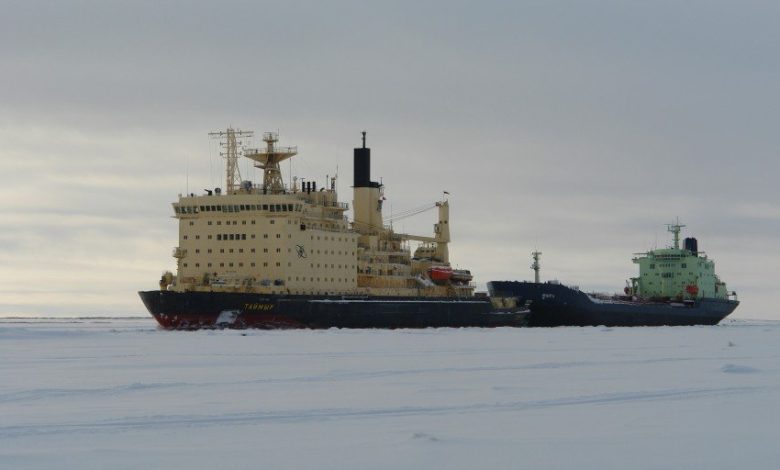Arctic shipping volumes falling despite record ice-melt

Oslo: No records for shipping through Arctic waters are likely to be broken this year, even though meteorologists are predicting almost unprecedented melting in polar waters for 2015.
Reports from US scientists out last week show sea ice in the Arctic is near its all-time minimum for the end of winter and could break the previous record in the coming fortnight. The receding ice could lead to longer window for Arctic shipping this summer.
However, less ice is unlikely to equate to more ships transiting the fragile polar waters, experts maintain.
“The ice coverage is not the main factor deciding number of vessels operating in the Arctic. After some years with increasing numbers of vessels trading the Northern Sea route, the last two years have shown a clear decrease in number of vessels,” Morten Mejlænder-Larsen, discipline leader for Arctic operation and technology at classification society DNV GL, told Splash. “The North-East and -West passages are shorter if you trade between ports at the northern hemisphere,” Mejlænder-Larsen added, “but there are several other cost drivers which makes the cost picture more balanced.”
He listed ice class, winterization, training requirements, ice breaker fees and waiting time as factors reducing the benefit of using the northern passages.
Lower bunker prices have also cut interest in the Arctic Ocean as a shipping route between Asia and Europe.
However, DNV GL’s Mejlænder-Larsen does see an increase in destination shipping in connection with the development of new oil and gas and mining projects in the Arctic and shipping related to the export of these resources.
Captain Tor Husjord, who heads up Norwegian think tank, Maritimt Forum Nord, told Splash: “Traffic in the Arctic has gone down although traffic for tourism has increased massively.”
“Owners thought they would find honey up north, and expectations shot trough the roof,” Husjord said. “You need to measure the facts, there’s a lot of red tape dealing with the Russians and very little structure and the handlings and operations are massively expensive up north,” he added.
Husjord did however predict more traffic in the Barents and Kara Sea where Norway’s largest undeveloped oil and gas fields are based. There are 10 highly advanced Norwegian offshore vessels and one rig working up there at the moment. Neighbouring Russia does not yet have the technology to utilise these resources, Husjord said.
Statistics from Russia also point to a decrease in Arctic shipping activity.
While 71 vessels transited the Northern Sea Route in 2013 up from 46 in 2012 and just four in 2010, the figure dropped to 53 last year despite the fact that the Russians issued more than 600 transit visas. Just 279,400 tonnes of goods were conveyed along the route, 80% less than in 2013. Pertinently, not a single ship sailed between a European port and an Asian port; every single journey was from one Russian port to another.
A new report on air pollution from ships in the high Arctic warns of huge increases in air pollution from shipping.
The International Council on Clean Transportation (ICCT) study is focused on the US High Arctic and looks at what the area might be like 10 years from now.
The report estimates that because of Arctic ice melt, shipping could increase in the next 10 years anywhere from 150% to 600%.
At the Arctic Summit, an event organised by The Economist in Oslo last week, the International Chamber of Shipping (ICS) stressed the critical importance of a mandatory and uniform regulatory framework to ensure maritime safety and environmental protection, as the volume of Arctic shipping gradually increases in response to new interest in developing the region’s natural resources.
ICS secretary general, Peter Hinchliffe, explained: “The International Maritime Organization is the appropriate forum for developing standards for ships operating in the Arctic as it has the necessary legal and technical expertise to take full account of the interests of all maritime nations including those with an Arctic coastline.”
He added that the shipping industry is fully committed to the implementation of the mandatory IMO Polar Code, following its recent adoption by IMO Member States and its expected entry into force in January 2017. “The Polar Code will deliver an even greater level of confidence in the environmental performance of shipping using a risk-based approach which addresses the hazards relevant to the type of ship operation, the ship’s location and the season of operation.”
Many green groups have attacked the Polar Code for not being more strict on what ships need to do when heading into Arctic waters. A poll last year commissioned by Greenpeace revealed that 74% of respondents agree or strongly agree that governments should create a protected area in the Arctic Ocean around the North Pole, providing a sanctuary for animals and other marine life. Moreover, 71% of those polled agree the entire Arctic Ocean should be free from oil drilling and other types of heavy industry.
With additional reporting by Hans Thaulow
